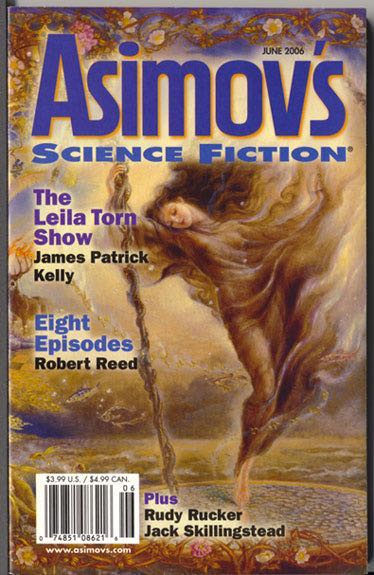Asimov's Science Fiction, June 2006
Reviewed date: 2006 Sep 3
144 pages
144 pages
None of the stories in this issue are worth rereading. A Flight of Numbers Fantastique Strange started off well but descended into incomprehensible mysticism. Life on the Preservation was interesting enough, but nothing to write home about. The Leila Torn Show is artsy but fails as a story.
The poems in Asimov's are usually a waste of space, but I enjoyed The Unified Field of Dreams Theory by Laurel Winter. It made me nostalgic and homesick for an Iowa cornfield, and I've never even been to Iowa or to a cornfield.
- Novelette: The Leila Torn Show, by James Patrick Kelly - Since when is anthropomorphizing a television show a good story idea?
- Novelette: A Flight of Numbers Fantastique Strange, by Beth Bernobich - A math student's twin sister repeats prime numbers to herself in an insane asylum, while math students at the university are being systematically murdered.
- Life on the Preservation, by Jack Skillingstead - Aliens keep one Earth city in a 24-hour time loop, and a young woman goes inside to destroy the loop.
- The Tiger in the Garden, by Scott William Carter - An ambitious young man sacrifices his career to save his old mentor, who is accused of having conspired against the Unity Defense.
- Eight Episodes, by Robert Reed - Eight poorly produced episodes of a canceled TV series tell the story of a tiny robotic alien spaceship that landed on Earth, and warns humanity that interstellar travel is impossible for anything except robotic scout ships; humanity will be stuck on Earth forever.
- The Ninth Part of Desire, by Matthew Johnson - A scientist working on emotion-inducing essences tries to find the perfect essence for his wife who has burned out her natural emotions by testing the essences.
- The Edge of the Map, by Ian Creasey - A journalist heads to the last part of the world not monitored by nanocams, in search of a story.
- Chu and the Nants, by Rudy Rucker - Humanity creates nanomachines; nanos turn Mars into a super-computer, then begin work on converting Earth into a similar computer.
